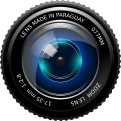Equipment
One of the most essential elements of action and sports photography is having the right gear. Among the useful tools you'll need to get started are some of the following:
Camera: A prompt and trustworthy camera is needed to record quickly moving activity. A camera with a rapid focusing mechanism and good low-light performance is what you should seek out. A camera with a crop sensor or a full frame camera can be used for sports and action photography.
A fast lens with a wide aperture will help you to capture more light and produce a shallow depth of focus. It is advised to use a 70-200mm or a 100-400mm lens for photographing sports and action.
Tripod: For camera stabilization and stable shots a tripod is a necessary tool.
Memory Card: To keep your pictures spend money on a quick and dependable memory card.
Battery: To avoid running out of power in the middle of a shoot, make sure you have spare batteries with you.
Settings
Once you have your equipment ready it's time to set up your camera for the perfect shot. Here are some tips for getting the best settings:
Shutter Speed: A fast shutter speed is crucial for freezing action. Use a shutter speed of at least 1/500th of a second or higher for sports and action photography.
Aperture: A wide aperture will give you a shallow depth of field and help you isolate your subject from the background. Use a wide aperture such as f/2.8 or f/4 for sports and action photography.
ISO: A high ISO will enable you to catch more light, but it will also make your pictures noisier. To get the ideal mix between image quality and low-light performance experiment with various ISO settings.
Focus Mode: Set your camera to continuous autofocus (AF-C) to track the movement of your subject.
Shooting Mode: Use the burst mode or continuous shooting mode to capture a series of photos in quick succession.
Techniques
You may enhance your sports and action photography using a number of strategies in addition to the appropriate tools and settings. The greatest advice is provided below:
Predict the Action: Predicting the action is one of the secrets to taking fantastic sports and action pictures. Try to predict where the action will be by paying close attention to the game or event.
Find the Right Angle: Play around with different perspectives to capture interesting and original images. To get a dramatic perspective, get low; to get a bird's eye view, get high.
Use Panning: Panning is a technique where you follow the movement of your subject with your camera. This creates a sense of motion and movement in your photos.
Sports and activity may evoke emotion. Photographing athletes' emotions is equally as important as documenting their physical performance. Attempt to document the moments of victory, failure, and tenacity.
Experiment with Lighting: The right lighting can make or break a sports and action photo. Try to take advantage of natural light, use reflectors to bounce light back into the scene, and experiment with flash to freeze action and add depth to your photos.
Post-Production
It's time to edit and improve your images once you've taken them. Following are some post-production pointers:
Choose the Best Pictures: Choose the finest photographs to edit from from all of your collection.
White balance and exposure adjustments should be made to ensure that your images appear their best.
Enhance Color and Contrast: Change the colors and contrast in your photographs to make them stand out.
Cropping and Resizing: To enhance composition, crop your photographs, then resize them to the right proportions for your intended usage.
Remove Distracting Elements: To make your photographs less distracting, use the clone and healing tools.
Conclusion
Sports and action photography can be an exciting and challenging field, but with the right equipment, settings, techniques, and post-production skills, you can capture stunning photos every time. Remember to anticipate the action, experiment with different angles and lighting, and capture the emotions of the athletes. Above all, keep practicing and have fun!

